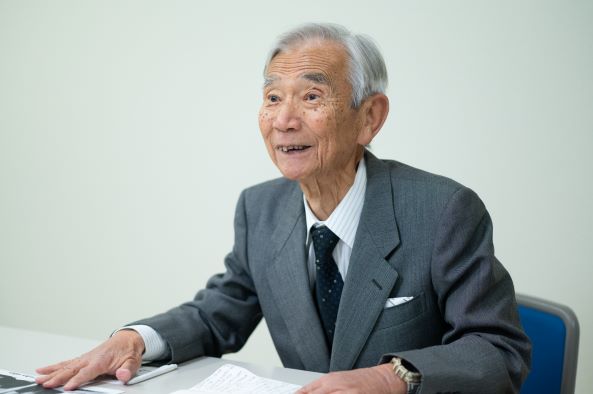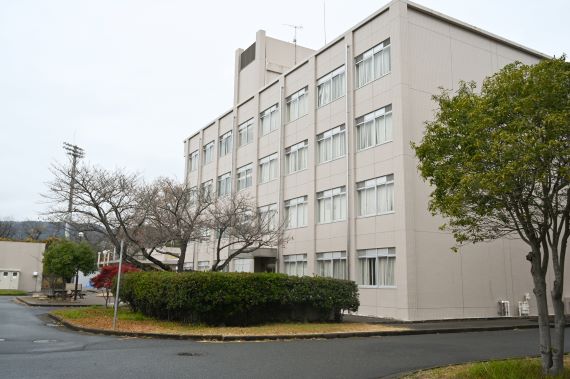The 75th Anniversary of JEOL Ltd. -Special Project
The path followed by the DA-1, the origin of developing the electron microscope by JEOL Ltd.
DA-1 is an electron microscope that was successfully developed for the first time and commercialized by the founding members of JEOL Ltd in 1947. In the R&D Bldg. at the head office, the valuable DA-1 instrument is sitting. The DA-1 in the R&D Bldg. was transferred from Ibaraki University in November 1975. What history has it followed thus far? We interviewed some of the people involved. A part of the history of this instrument coming to JEOL has been known.

DA-1 in R&D Bldg.at the Head Office
DA-1 to Ibaraki University
It was 1951 when the DA-1 was installed at Ibaraki University. We checked into the situation then with Takashi Inami, secretary-general, Alumni, Engineering Department, Taga Kougyoukai, Ibaraki University, (then in 2023) but details were not kept.
Then, how did the DA-1 come to Ibaraki University? The interview team was able to listen to the story by Ryouichi Urao, Emeritus Professor, former professor of the Engineering Department, Ibaraki University (86 years old: then in 2023). He had not been assigned to Ibaraki University in 1951 when the DA-1 was installed. So, the story about the installation includes stories heard from others that were involved.

Ryoichi Urao, Emeritus Professor

Dr. Urao viewing the photo back then
"I heard that Professor Masanosuke Tozaki, the Dean, Engineering Department (later, the 5th president, Ibaraki University) then in 1951, contacted Mobara and obtained the DA-1. He viewed that having no electron microscope, the most advanced instrument was a problem in conducting research activities for Tadashi Chihaya who was engaged in metal material research, and was coming to the Engineering Department, Ibaraki Department. "(Dr. Urao)
Mobara seems to mean the Electron Science Laboratory, in Mobara, Chiba prefecture, which was the predecessor company of JEOL.
Special electron microscope
It was exclusively Dr. Chihaya who used the DA-1 installed at Ibaraki University. However, by the time Dr. Urao arrived at the university, it was hardly used at all. Dr. Chihaya became a professor and also served as Dean of the Engineering Department. He spent most of his time in the Dean's office, far from the laboratories, and the room where the DA-1 was placed. Maybe that was the reason.
After taking the office, Dr. Urao was to take care of laboratories, on behalf of Professor Chihaya, who became busy. Dr. Urao had operated the DA-1 only a few times. This was not used often because of the consideration "it was an instrument mostly used by professor Chihaya" and because of the uncertainty of the instrument that was already an "old model". To ensure stable operation, a rechargeable battery was prepared as power source. It was charged from daytime until around 11 pm, then observations started. It was said to be only two hours or so that the DA-1 could operate.

The building where DA-1 was once installed
Both exterior and interior appearances have been refurbished

The place where DA-1 was once installed
Professor Chihaya, sometimes left the Dean's Office and came to the laboratories. He talked to Dr. Urao and others and then returned to his office. The topic was sometimes about the progress of the experiment, and sometimes the DA-1. According to Professor Chihaya, the instrument in Ibaraki University was the one that was manufactured in the early days.
DA-1 Found

Dr. Kanichi Ashinuma adjusting DA-1
On July 10, 1975, a sales representative visited the Ibaraki University. It was Mr. Shinichi Watanabe (present adviser), who joined JEOL two years before then.
At that time, the Engineering Department of Ibaraki University was not a JEOL user. Despite expectations to be unwelcomed, Mr. Watanabe was welcomed unexpectedly. "We will show you something". They brought Watanabe to the warehouse. Then there was an old electron microscope that he had only heard about. It was the moment when a JEOL employer found the existing DA-1.
However, it was difficult to judge if it was genuine or not for Mr. Watanabe who joined the company a little while ago. So, it was checked by Dr. Kanichi Ashinuma, one of the designers of DA-1 later. Dr. Ashinuma felt deeply about it. Because the DA-1 was there that he completed after huge efforts 28 years ago.
It didn't take long after that for people to start asking, "Can't we bring Ibaraki University's DA-1 back to JEOL?"
DA-1 to JEOL
Mr. Watanabe and others went to Ibaraki University on September 17, 1975 again to discuss the transfer of DA-1. On October 20 of the same year, the DA-1 was handed over and installed in the R&D Bldg. at the head office.
Since then, the DA-1 has been kept in the showcase in the R&D Bldg. along with a "Design Note" by Dr. Kazuo Ito, one of the designers, same as Dr. Ashinuma, and "Electron Microscope" written by Dr. Daisuke Kuroiwa, which inspired Mr. Kenji Kazato, the founder of JEOL Ltd. , to produce this electron microscope, to welcome users from all over the world.
"Transmission Electron Microscope DA-1 and the Design Note" was registered as Important Historical Materials of Science and Technology (Heritage of Future Technology) in the fall of 2010 by the National Museum of Nature and Science. In the fall of 2012, it was also selected as "the Heritage of Analytical and Scientific Instruments" which was jointly established by the Japan Analytical Instrument Manufacturer's Association (JAIMA) and the Japan Scientific Instruments Association (JSIA).
The Microscopic World and the Development of Science

Mr. Kazato, the founder of JEOL Ltd.
The following are the words of Mr.Kazato.
"Japan, along with the U.S., is now a world power in high-end scientific instruments, and although it will be some time before we see results, let us trust and rely on the youth of Japan to accomplish the great task of building our nation! Trust that our genes are passed on to them!"
This message which must have been sent to future unseen JEOL employees, has been passed on timelessly. JEOL continues its challenge for the world's first, world's highest technology today.
